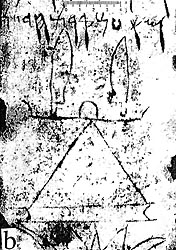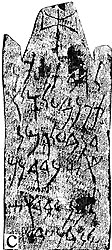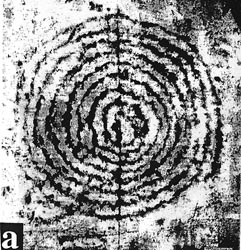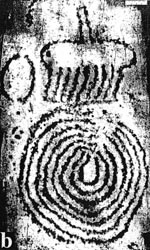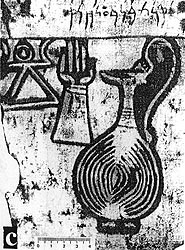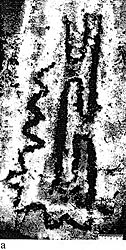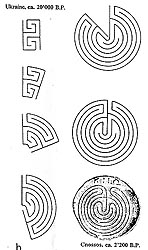NEWS 95 - Symposium 2A: semiotics, signs and symbols
The LA B R Y S symbol, initiatic or sacrificial?
Leo DUBAL
Abstract. The technological shift from bronze to iron might
have been the prime mover of an even more dramatic shift of paradigmatic nature, i.e. the
shift from matrifocal to patriarchal social organisation. Rock art from this crucial
period for humankind provides testifying records of the confusion which arouse then and
lasted a long while. Labrymorphic and labyrinthic symbols will be discussed.
|
|
A puzzling piece of rock art reported by Waites[1] is the 4'000 years old Minoan schist mould, shown in Fig.1a, displaying the Mother Goddess holding two labrys, two double-axes in her hands. The labrymorphic appearance of the Goddess' body suggests that the axes have an initiatic meaning more than a sacrificial one.
The labrys might have been made out of stone at the time they were first depicted on a dish, in Statinice, in Bohemia, 7'000 years ago [2], but I tend to believe that they were one of the very first objects to be manufactured in bronze.
The "cult of the labrys" seems to have been initiated in Asia
Minor, in Caria, a land inhabited by matrifocal tribes. Caria deserves therefore to
be called the "Home of the Labrys". As the mould with the Cretan Mother
Goddess testifies for, the Carians did manage to convert to their cult the great
matrifocal civilisation of Crete, the Minoan civilisation.
|
|
Fig.1b shows a "tactigramme" (see Ref. [3],[4]) of a Punic votive stele with the sign of Tanit, the Goddess of Carthage, holding, in place of the labrys, two threatening knives. Such attributes might well have had a "sacrificial" signification as indeed the holocaust of new born children was a fairly common ritual in Carthage. The stele shown in Fig.1c demonstrates that the labrys might take an initiatic dimension as it appears as a substitute for the labrymorphous Goddess. The labrys symbol could therefore be seen as fulfilling two roles: initiatic & sacrificial.
Fig.2a shows another initiatic symbol: the spiralling labyrinth. Looking at this labyrinth from its center outwards, it recalls the path to birth, while from outside inwards, one can see a metaphor for life itself. This matrifocal symbol is found all over the world, a reminder that "herstory" was present well before "history" began, as Sig Lonegren [5] phrases it.
Fig.2b shows a onion-like labyrinth. The meaning for the nearby "comb" is obscure. May be it is the magic tool to draw such labyrinths? By the way, the stampings for tactigrammes in Fig.2a,2b,3a have been realised in the company of Kalle Sognnes, in May 1995, at the Lerfall site, near Trondheim.
On the votive stele of Carthage depicted in Fig.2c, the sign of Tanit is no longer the leading symbol. This tactigramme provides an excellent piece of evidence for the universality of "onion-like" labyrinths.
Fig.3a shows the tactigramme of a decorative meander pattern, another
piece of rock art from the Lerfall site. This kind of matrifocal symbol was already
present in Palaeolithic times, at least 20'000 BP [2].
|
|
As shown in Fig.3b (see Ref.[5]), the most exciting property of such a meander pattern is that it let itself be topologically transformed into the Cretan monocursal labyrinth, the one which decorates the silver Greek coins of 200 BC [6]. We have to underline Cretan labyrinth and not Minoan, because drawings of labyrinths appeared only long after the eradication by earthquake of the Cnossos Palace, the event which started the downfall of the matrifocal Minoan society as well as the Greek settlement in Crete. The Cretan labyrinth demonstrates the survival of some matrilinear symbolism into a patriarchal era.
By imprinting the Cnossos coin one gets its "negative", i.e. its "mould". The result is stimulating: as shown in Fig.3c, the pattern is similar to the labyrinth on Naquane's great rock, in Valcamonica! Maybe the Camunians obtained from a traveller the imprint on clay of such a labyrinthic coin? There is only a sketch, but no tactigramme to show, of the Naquane Rock Art Labyrinth: to date, the "Soprintendenza Archeologica della Lombardia" (Prot. #2248, April 16, 1993 & #4215, June, 2nd, 1995) has denied to me the authorisation to perform the necessary stamping. By the way, the comparison between two published pictures, see Ref.[7], demonstrates very well the limits of photographic recording of rock art with its parallax distortions!
Approaching the last curve of this labyrinthic adventure, one still has
to find an Ariadne's Labrys to break a way out! Labyrinths, Labyrinthos,
is not an indo-european word. It is a loan word, borrowed from the Carian, I would guess
at the end of the second millennium, at a time when somebody succeeded to draw Cretan
labyrinths: a new word was needed in order to invent new myths, and add to this
"initiatic" symbol a "sacrificial" dimension!
|
|
I called previously Caria the "Home of the Labrys"; now I would like to suggest that the word Labyrinth originally meant the "Home of the Labrys", too. After all, the northern border of Caria is nothing less than the "Meander River" (now called the Menderes River).
As Lonegren suggests [5], most probably the whole sacrificial mythos of Theseus & the Minotaur has been created by the Athenian settlers, in Crete, in order to make their ancestors look great, heroic. But this mythos does not hold water: one cannot get lost in a monocurval labyrinth. There is, therefore, no historical ground for the Minoans' surrender to Athenians (such as Ariadne's love for Theseus), nor for pre-hellenic Athenian inventiveness (such as Daedalus' labyrinth). In short, the superiority of pre-hellenic Greeks to Minoans is a later mythos justifying a posteriori the patriarchal dominance over a decadent matrifocal civilisation.
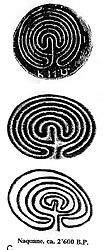
Fig. 3. The path toward the Camunian' Labyrinths:
c) The "Imprint" and the "Copy" (Mirror image: after Ref.[6]; Same, retouched, with 75% vertical reduction; Sketch of Naquane Labyrinth: after Ref.[5]).
Those considerations lead to paleometallurgy. The shift from bronze to iron seems to have been the prime mover of an even more dramatic shift of paradigmatic nature, i.e. the shift from matrifocal to patriarchal social organisation. While bronze technology is quite straightforward, the chemical reduction of iron ore needs a consequent step-by-step process, leading to the emergence of homo faber. I even postulate that the shift from bronze age to iron age requires the discovery of causality. Such a discovery is bound to the acknowledgement of the role of paternity in procreation. This is quite an intimate step in mental development which, from then on, everyone has to learn for himself. In turn, the acknowledgement of paternity in procreation provoked an innovative kind of mythos dealing with the procreation, e.g. of monsters, such as the mythos of:
Bull + Pasiphaë -> Minotaur.
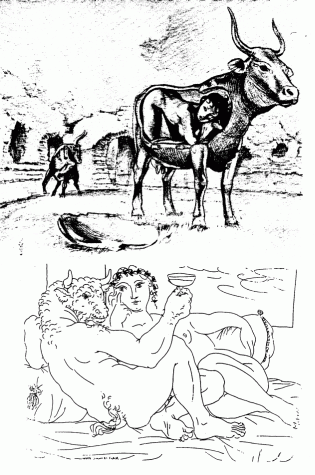
In conclusion, the confusion resulting from this shift in social organisation found its best expression in Rock Art with the mixing into initiatic (matrilinear) symbolism of sacrificial (patrilinear) elements.
Leo DUBAL
Virtual Laboratory for Archaeometry
vla@worldonline.fr
REFERENCES
[1]The Deities of the Sacred Axe, Margaret C. Waites, Am. Jour. of Archaeology 27 (1923), pp. 25-56
[2] Maze Pattern, Aidan Meehan, Thames & Hudson (1991), ISBN 0-500-27747-8
[3]Tactigraphy, a New Method for Recording Rock Art Engravings, Leo Dubal, these proceedings.
[4]Atlas pictographique, 243 tactigrammes inedits de steles votives de Carthage, Léo Dubal, Monique Larrey & Louis Spiro, Autopublication (1993),see also L'Harmattan (1995)
[5]Labyrinths, Ancient Myths & Modern Uses, Sig Lonegren, Gothic Image Publ. (1993) ISBN 0-906-362-16-4 /trad. franc.:Les Labyrinthes,Dangles (1993) ISBN 2-7033-0381-5
[6]Cnossos Silver Coin #(1926)1-16-117, British Museum, see also
Catalogue of the Greek Coins: Crete and the Aegean Islands, Warwick Wroth, Pl. VI
#5, A. Forni (1963)
[7]La civilisation du Val Camonica, Emmanuel Anati, Pl. 47, Arthaud 1960); & Gravures
rupestres dans les Alpes, Ausilio Priuli, p.15, Glenat (1984), ISBN 2-7234-0388-2

